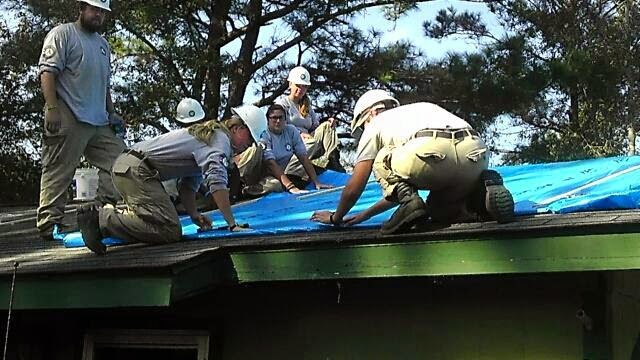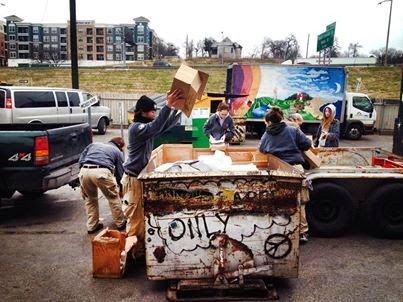Wondering what program is right for you? Brittany served with both NCCC and FEMA Corps, and told us about her experinces this week. She served as an NCCC corps member out of the Southern Region, and a FEMA Corps team leader with the Southwest Region.![]() I was first introduced to AmeriCorps NCCC during my senior year of high school, when a classmate told me about a community service program she was serving with before attending college. My first thought was “What the heck is AmeriCorps?” From that moment I learned about the program, I knew it was something I needed to be part of. I had always been involved in organizations with strong member bonds and support, such as drama club and my college rugby team. I also knew I loved to make people happy. My parents had just moved away from my childhood home of Long Island, NY, and I needed to detach myself a bit. I knew that this was the perfect opportunity to find my life’s direction, and to challenge myself by entering into something blindly. I will never forget the day I received my acceptance email. I was at work waiting tables. I knew it was a long shot I would even get accepted, and suddenly I found out I would be traveling to Mississippi for a ten month adventure of a lifetime! I knew from that moment on that my life had a bigger purpose.
I was first introduced to AmeriCorps NCCC during my senior year of high school, when a classmate told me about a community service program she was serving with before attending college. My first thought was “What the heck is AmeriCorps?” From that moment I learned about the program, I knew it was something I needed to be part of. I had always been involved in organizations with strong member bonds and support, such as drama club and my college rugby team. I also knew I loved to make people happy. My parents had just moved away from my childhood home of Long Island, NY, and I needed to detach myself a bit. I knew that this was the perfect opportunity to find my life’s direction, and to challenge myself by entering into something blindly. I will never forget the day I received my acceptance email. I was at work waiting tables. I knew it was a long shot I would even get accepted, and suddenly I found out I would be traveling to Mississippi for a ten month adventure of a lifetime! I knew from that moment on that my life had a bigger purpose.My team's first project was at Camp High Road in Middleburg, VA, where we led diverse groups of campers (Boy and Girl Scouts, home school groups, special needs and at-risk youth, etc.) in high and low ropes team building challenge courses. We also helped prepare the camp for the upcoming summer season, and performed tasks like painting, weed whacking, cleaning cabins, and installing a fence for a horse field.
For our second project, we served at Second Harvest Food Bank of New Orleans, where the team assisted the food bank with their summer feeding program. We helped prepare, plate, and track over 6,000 meals per day for kids who would ordinarily be on the free lunch program. Over nine weeks, we served over 139,000 healthy meals to underprivileged kids!
Our third project was at Historic Westville, Inc. in Lumpkin, GA, a 1850s reenactment village. We helped completely renovate the museum's bathroom facilities, and provided a much needed facelift to the outside of an old house that would become a children’s educational center. We also spent three weeks at the University of Southern Mississippi’s Gulf Coast Research Laboratory in Ocean Springs, MS, where we cleared debris from six miles of trails left over from Hurricane Katrina, and created new connector trails. We cleared over 8,000 lbs. of trash in three weeks!
Our fourth project was all over the place! We spent our first week in Memphis, TN working with an organization that helped beautify inner-city Memphis through many local initiatives, including participation in art festivals and the upkeep of abandoned home properties to decrease trespassing and gang activity. After a week there, we were called back to the Mississippi Gulf Coast to work with a local religiously affiliated non-profit assisting with roof repairs, home damage assessments, mucking and gutting, and grant applications resulting from Hurricane Isaac. We were stationed in many towns up and down the Gulf Coast including: Bay St. Louis, Ocean Springs and Pass Christian, MS.
![]()
I was halfway through my NCCC corps member year when we met the inaugural class of FEMA Corps in Vicksburg. I wanted a well-rounded service experience and knew nothing about FEMA. I had never thought about any sort of future in emergency management, but had heard a lot about the program from FEMA Corps members. The program was still brand new, and there were many unknowns. However, the facts stood: I knew how strong I was in an administrative setting, and knew that I would be a strong team leader in such an environment. FEMA Corps was still national service and still an AmeriCorps NCCC program. It was another adventure where I could effect change, and get the chance to help people. I was interested from the get go, and I accepted the chance to serve as a team leader in Denver without hesitation.
While serving with FEMA Corps, my team worked out of Denton, TX completing Disaster Survivor Assistance training, and then helped to pilot this new program after the West, TX fertilizer plant explosion of April 2013. From there, we assisted survivors in registering for aid after the Moore, OK tornados in May 2013. We also worked in hazard mitigation in response to SuperStorm Sandy in Long Island, NY and deployed to the Colorado flooding in fall 2013.
What were your most memorable experiences while serving?
NCCC: While we were stationed in Ocean Springs, MS serving with the University of Southern Mississippi’s Gulf Coast Research Lab and Marine Biology Center, our supervisors offered us a thank you boat ride and tour of Horn Island, which is about eight miles off the coast. We got to experience a day in the life of a marine biologist, and learned a lot about marine life. We assisted catching and netting fish, and watched as dolphins followed our boat. We pet stingrays, ate lunch on a deserted beach, and played in crystal clear water. The team bonded so much that day, and after all of our hard work clearing trails, it was a great day-cation. It was such a memorable experience for me.
FEMA Corps: Hands down the most memorable experience was our first disaster deployment. My team was deployed to West, TX after the fertilizer plant explosion that devastated the 2,800 person town. Our project was to pilot the newly created Disaster Survivor Assistance program, in which FEMA brings the disaster aid registration process to survivors through iPad technology.
This was our first glimpse into what I could only compare to a war zone, where we first stared into the eyes of people who had just lost everything. We encountered people well into their 90s who had lived in the same house their entire lives, and were forced to start over. Despite all of this, they were extremely positive. I can’t tell you how many times I heard “It could have been so much worse.” or “It’s just material, I still have my family”. Many times people would tell us they were standing on the pile of rubble that was once their home. It became real to all of us instantaneously. The people of West welcomed us right away, and seemed to really appreciate that we were young people dedicating time to serve their community.
Since the disaster was so confined, we had the opportunity to work one-on-one with FEMA staff in the field. We had an amazing FEMA supervisor who I still communicate with on a regular basis as a mentor.
We were also able to experience some of the amazing Czech culture in West. We learned simple phrases like děkuji (thank you), and ate Kolachies and Czech pastries for days!
In those initial 10 days, we all became a family. We walked into that experience with no idea of what to expect, and left with such amazing new perspectives on disaster areas and community. This experience really helped our team to come together for the first time.
What was it like to serve for two consecutive years - one with NCCC and one with FEMA Corps?When I say that traditional NCCC and FEMA Corps are different, I really mean it. They are two programs, with a common stucture and mission, serving on very different types of projects.
I never worked anything but an 8am-5pm schedule while serving with NCCC, and I think my team worked a normal 8am-5pm schedule only one out of the ten months in FEMA Corps. I spent the entire year in NCCC living on $4.75 a day, where eating out was a very rare treat. With FEMA Corps, because we were serving out of disaster areas, we had very limited kitchen access, and got pretty sick of eating out most days. I also felt like I lived a bit more minimally in NCCC for many reasons.
Of course there are the obvious differences as well: We had constant access to a laptop, internet, and a blackberry in FEMA Corps, whereas we walked a mile or drove to a Starbucks for Wi-Fi while in NCCC. It was normal to work with giant paint stains on our uniforms in NCCC, but in FEMA Corps we kept our uniforms neat and clean because we were in a professional setting.
The logistical differences are really astounding, but not as astounding as the differences in service. NCCC is very physically tiring, heavy lifting work much of the time, but I have never felt as physically and mentally exhausted as I did after the first two weeks of a newly active disaster while serving with FEMA Corps. Working with non-profit organizations through NCCC is also completely different than working with a government organization like FEMA. There are more procedures to follow in FEMA Corps on the FEMA side, including adhering to a double chain of command (NCCC and FEMA).
Check back tomorrow for the rest of our conversation with Brittany - she'll explain the differences between serving as a member vs. a team leader, how NCCC and FEMA Corps helped her to grow, and talk about what she's doing now.
































































